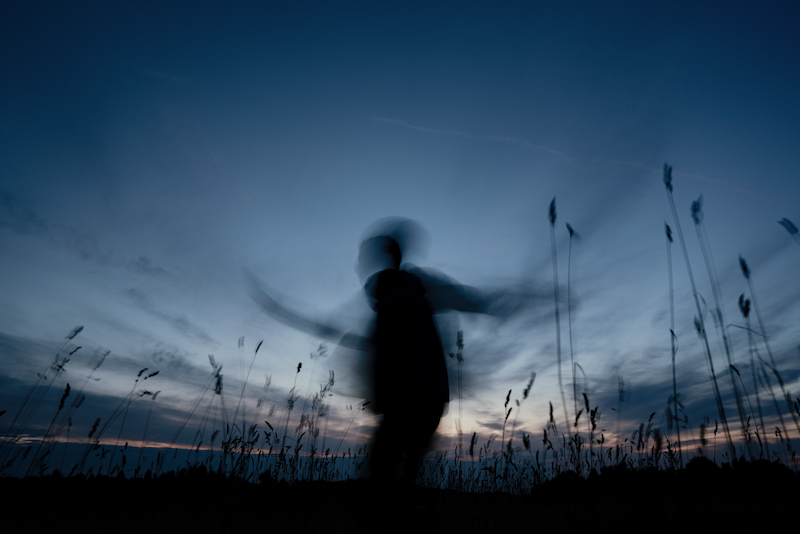Blurring the Lines: Expanding Literacy and Arts Education

The photo is taken outdoors at dusk. A person stands in the foreground amid sea oats or another perennial grass. The person is photographed while moving arms and body, creating a blur that mirrors the gauzy cirrus clouds in the background. The last light of the sun paints the darkening sky and clouds with orange, pink and shades of blue and leaves the person and accompanying flora in blurry silhouette. Photo by Simon Migaj on Unsplash
The impact of Amanda Gorman’s inaugural poem was undeniable. The visual effect of red headband, yellow coat, updo with gold mini-cuffs. The hypnotic meter and rhyme delivered with authority and precision. The floating, choreographed hand gestures. The powerful word images demanding attention.
In K-12 public education, literacy can include the literary arts — creative writing and poetry — and has long been primarily the domain of English Language Arts (ELA). The learning standards for poetry live within ELA curricula. While poetry is certainly an art form, it is not commonly included among arts education disciplines (dance, media arts, music, theatre and visual arts). Nor is it specifically included in the National Core Arts Standards definition of artistic literacy. However, the National Endowment for the Arts and many state and local arts councils do include the literary arts in their granting portfolios.
Amanda Gorman got her start at WriteGirl, a creative writing and mentoring organization that brings together poetry and the arts. Southern Word, a youth development program in Nashville, blends ELA and artistic literacies using spoken word and music. Southern Word reaches youth primarily through school-based residencies in ELA classes, with additional outreach through community workshops and community performances. And because music is especially relevant in Nashville, Southern Word also includes programs in music production and writing across genres. What is songwriting after all, but poetry set to music (or beats)? Organizations such as WriteGirl and Southern Word support young people to build artistic and ELA literacy in impactful ways. Southern Word Director Benjamin Smith shares that Southern Word programs, “equip youth with the tools to transition from passive consumers into active thinkers, creators, and projectors of their own positive identity.”
Creative youth education programs, similar to Southern Word, stand at the intersection between ELA literacy, K-12 arts education and broader youth development programs. These organizations are helping to close a gap between discipline-based arts instruction offered in schools and learning taking place out of school, including after school classes, and adding depth and richness to the learning experience. Young people — especially those who attend schools with fewer opportunities in the arts — stand to benefit when schools and community partners work together. Community partners bring an arts-centered perspective, giving schools the opportunity to look at learning through a different lens. Examples of community partner programs and outcomes may be found in ArtsEdSearch research. These types of programs create robust learning experiences through culturally responsive programs that offer youth opportunities to engage in activities that encompass a comprehensive definition of the arts. Creative education is not limited to the school classroom nor does it stop when the bell rings.
Amanda Gorman’s inaugural poem encompasses both literary and performing arts, highlighting the interdisciplinary nature of creativity itself. There are many individuals in our communities who share Amanda’s passion and desire to tell their stories. Blurring the lines of art and literacy education create opportunities for others to listen.
Here are some places to start blurring the lines and embracing the creative potential for all young people:
- Find a local creative youth development organization and get involved as a volunteer or donor. Check out your local and state arts councils for a list of grantees.
- If you are an arts teacher/administrator, reach out to your colleagues in English Language Arts and English Language Learner departments and look for ways to collaborate.
- Ask funders to help in blurring the lines between separate granting categories for the arts, education and creative youth development.
- Check out these national organizations for ways to support young people’s creative potential:
-
- Creative Youth Development National Partnership works with national partners to advance creative youth development through visibility, funding and field building. Look for an active network near you.
- Creative Generation works to inspire, amplify and connect the work of young creatives through research, professional learning and leadership development.
- Check out more organizations that build community capacity to blur the lines, including National Guild for Community Arts Education, Young Audiences: Arts for Learning and Save the Music Foundation.



